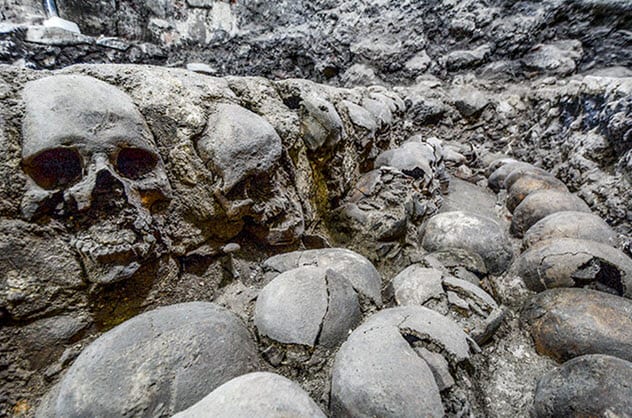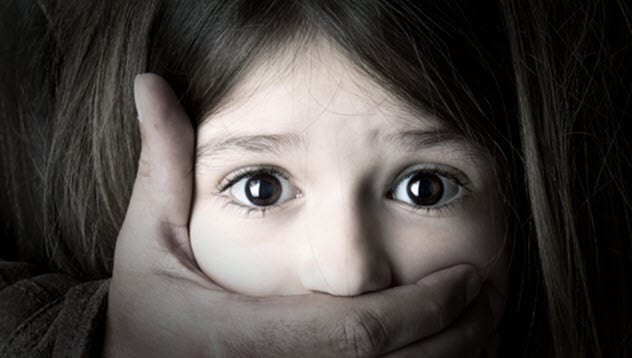 Humans
Humans  Humans
Humans  Gaming
Gaming 10 Overused Game Villains
 Mysteries
Mysteries Ten Mysterious “Ghost Ship” Stories That Still Keep Us Wondering
 Technology
Technology 10 Times AI Replaced Humans (and No One Noticed)
 Politics
Politics 10 Dreaded Despots Who Met Untimely Deaths
 Pop Culture
Pop Culture 10 Celebs Who Have Surprisingly Wanted to Be on Reality TV
 Creepy
Creepy 10 of the Strangest Popular Creepypastas
 Animals
Animals 10 Animals That Used to Be Bigger
 Our World
Our World 10 American Cities, Towns & Villages That Are Unlike Any Other
 Movies and TV
Movies and TV 10 Huge Movies Almost Made by Other Directors
 Humans
Humans 10 Real Life Versions of Famous Superheroes
 Gaming
Gaming 10 Overused Game Villains
 Mysteries
Mysteries Ten Mysterious “Ghost Ship” Stories That Still Keep Us Wondering
Who's Behind Listverse?

Jamie Frater
Head Editor
Jamie founded Listverse due to an insatiable desire to share fascinating, obscure, and bizarre facts. He has been a guest speaker on numerous national radio and television stations and is a five time published author.
More About Us Technology
Technology 10 Times AI Replaced Humans (and No One Noticed)
 Politics
Politics 10 Dreaded Despots Who Met Untimely Deaths
 Pop Culture
Pop Culture 10 Celebs Who Have Surprisingly Wanted to Be on Reality TV
 Creepy
Creepy 10 of the Strangest Popular Creepypastas
 Animals
Animals 10 Animals That Used to Be Bigger
 Our World
Our World 10 American Cities, Towns & Villages That Are Unlike Any Other
 Movies and TV
Movies and TV 10 Huge Movies Almost Made by Other Directors
Top 10 True Stories More Interesting Than The Myths They Inspired
From urban legends to ancient mythology, we have used our imaginations to map the landscape of reality. It is not simply that we create stories to explain puzzling phenomena. Sure, we do that from time to time. But we also tell our extraordinary, sometimes mystical, tales in a way that’s meant to teach timeless life lessons to future generations.
Sometimes, though, reality does a better job for us than the most captivating urban legends. In this list, we’ll look at 10 instances where the true stories are far more compelling than the fictions they spawned.
10 True Origins Of Myths And Legends
10 Why Takako Konishi Died
According to urban legend, a silly Japanese tourist went to Minneapolis in 2001 after watching the Coen Brothers’ movie Fargo. Then she traveled to North Dakota because she was convinced that she could find the money buried by the fictional character played by Steve Buscemi.
What really happened to Takako Konishi is a whole order of magnitude more interesting. Takako worked for a travel company in Tokyo. When the company went bankrupt, she struggled to secure another job and turned to the bottle for comfort.[1]
It seems that she had a complex life tinged with sadness. Some have suggested that she went to Minnesota because she had previously been embroiled in a passionate affair with a married US businessman. The relationship disintegrated, leaving Takako loveless as well as jobless.
In the US, she found a pretty spot in the woodland near Detroit Lakes, Minnesota, drank two bottles of champagne, and simply lay down in the snow until she died. (Detroit Lakes is less than 80 kilometers (50 mi) from Fargo.)
Real stories like this are so much richer, sadder, and more complicated than what is essentially a cruel joke masquerading as an urban legend. But as the saying goes, “Silly sells.”
9 The Americas Were A Harmonious Utopia Before Europeans Arrived . . . Or Populated By A Bunch Of Savages

According to Louis CK’s comedy routines, Native Americans, Canadian First Nations, and pre-Columbian Mesoamericans were just living “coast to coast green and brown and beautiful [with] all the humans . . . just walking around with painted faces . . . [eating] from the ground. And then they’d sleep on the grass. And they’d wake up, and they’d f—k. And then they’d go for a swim and do a little dance. That was the whole continent.”
Nope. Not true. In addition, these native peoples were not universally savage, baby-eating monsters with no semblance of civilization. These “black-and-white” views of history don’t help anyone, least of all Native Americans. They’ve had their culture and history systematically rewritten as a matter of politicized gamesmanship since before the 20th century.
Were there instances of war? Yup, just like Europe. Human sacrifice? Lots, just like Europe. Massacres? You betcha, just like Europe. The same can be said for Asia, Africa, and Australia.[2]
They were human beings. Sometimes, they did evil things to each other. Other times, they invented astronomical and writing systems, built cities, traded across the continent . . . like humans do everywhere else. Now that we know that people have inhabited the Americas for a lot longer than was once believed, we can only hope that the dehumanizing and naively idealized stories of indigenous peoples can be put to bed.
8 Catherine The Great Or Catherine The Nymphomaniac?

Character assassination has always been an effective form of propaganda. Humans put a lot of stock in “character” and the perceived flaws therein. How would you feel about supporting a leader that may have engaged in sexual congress with a farm animal? The British public wasn’t too pleased with Prime Minister David Cameron’s alleged acts of necrophilia and bestiality.
Although it may be true that Catherine the Great, empress of Russia, was a bit partial to male company, one cannot describe her as a nymphomaniac. The slur stuck, however. One tale even suggested that her death was brought about by a vigorous session of lovemaking with a horse.
This rumor seems to have begun after her death and lasts to this day. It’s the sort of factoid that often gets glibly passed around as a funny little truth about kooky figures in our past.
In reality, Catherine the Great died of a stroke. The amazing story of how she is perhaps the most notable monarch in Russian history is all but ignored in favor of a titillating lie. This speaks volumes—sex sells, even when it’s horse pucky.[3]
7 The Dirty Collyer Brothers
Two lives, a modern tale of brotherly love, hoarding, urban living, and the march of time can easily be boiled down to an admonishment: “You’re as dirty as the Collyer brothers.”
Without the wider context of these fascinating individuals, this little saying employed by older New Yorkers holds no meaning. But even if you are aware of the story, it borders on the tragic to reduce the facts to a simple throwaway line about scruffiness.[4]
We don’t have enough space to fully discuss the compelling tale of Homer and Langley Collyer, but the video above will give you the full context. Nevertheless, a brief overview should explain the quote that started this entry.
For a long while, Homer and Langley Collyer were functioning members of society. Homer was a lawyer, while Langley sold and repaired pianos. When their parents passed away, the brothers slowly retreated from society and became shut-ins.
Over the years, they amassed a huge amount of stuff. From piles of newspapers dating back decades to pianos and other bulky pieces of dark wood furniture, their Harlem brownstone became a junk-laden tomb that hid their corpses when they died. Check out the full history of these New York legends to get a clearer image of who they were and the society they shied away from—they were more than a simple mothers’ saying.
6 A Darwin Award, A Myth, And The Real Deal
In the early 1990s, the Darwin Awards were created to recognize those individuals who had lost their lives in the stupidest possible ways. It was humorously declared that they had removed themselves from the evolutionary tree of life and benefited all of us. Except one of the original prizewinners didn’t exist. How embarrassing.
In 1995, the Darwin Awards told the tale of an Arizona native who thought it was a great idea to attach a JATO rocket (an incredibly powerful thrust engine that assisted jets during takeoff) to his car. When the driver engaged the rocket, it took off, smashing into the side of a cliff.
Ha! What an idiot . . . except it never happened. But fear not, lovers of all things weird and wacky. Bob Lazar to the rescue.
According to rumor (and his own claims), Lazar had worked on a secret US project that studied a crashed UFO. So he may have made contact with aliens . . . or maybe not. But one thing is definitely real in his life story. He did, in fact, attach a jet engine to his Honda. And he didn’t die, which is way cooler.[5]
10 Ridiculous Health Myths (Science Says Are Actually True)
5 Rosie The Riveter, Am I Right?

“Rosie the riveter.” Looking at the right side of the above image, she’s the overalls-wearing, determined-looking lady with the polka-dotted bandana who’s showing off her arm muscles, right? Yeah, that’s not her.
The figure on the right side of the image was on a World War II poster circulated by Westinghouse Electric for a grand total of two weeks. Hardly a phenomenon.
It wasn’t until the 1980s that the poster resurfaced. At that time, the picture was repurposed from wartime propaganda to an iconic symbol for second-wave feminism, and a name was attributed to the lady—“Rosie the riveter.”
The woman in the original Westinghouse poster was actually known as the “We can do it” lady. So, who the hell is Rosie the riveter?
Well, Rosie was on a Norman Rockwell cover of a 1943 edition of The Saturday Evening Post. She was a symbol of America’s women plugging the gap left within industry by the scores of men fighting in Europe and the Pacific.
So why is the “real” Rosie better than the one we all see in our mind’s eye? The real Rosie has a sandwich. And sandwiches make everything better.[6]
4 Mountain Giants And Dark Watchers
If you’ve ever done a solo hike on a mountain range, you’ll recognize the feeling of being watched, impending doom, imminent danger, and general dread that can come about when the weather changes. And in the mountains, this happens every half hour or so.
When we get tired, dehydrated, or uncertain of our surroundings in the wilderness, our reptilian brain kicks in and our threat perception ramps up to 11. We notice the monsters that will do us harm.[7]
But there are no monsters. Still, from the highlands of Scotland to the California peaks, hikers have claimed that shadowy humanoid giants often appear in the distance. These creatures seemingly stalk the hikers as they attempt to traverse the tricky terrain.
This is actually a trick of the light. The phenomenon is known as a “Brocken specter,” and it looks cool as hell.
But imagine being in a heightened state while lost in the mist atop a high peak when you see a haloed giant that is staring at you just off in the distance. Would you be scared? Armed with knowledge of the Brocken specter phenomenon, you can instead snap a pic of it and put it on Instagram.
3 Craig Shergold And His Greeting Card Cure

Even the most uplifting stories can have darker, more compelling realities behind them. Little Craig Shergold was a very ill young boy—he had brain cancer. The heartwarming response from the public—he received tens of millions of get well cards—is usually where the story ends. But this tale continued, even after little Craig was saved by pioneering surgery.
The Royal Mail had to give the Shergold family their own postal code due to the storm of cards that Craig received over the years. At least 350 million have been sent to date.
However, what started as an uplifting, record-breaking event turned into a living nightmare for Craig and his family. The original “and finally” type of news reportage was actually a case of pathological sympathy and the public’s addiction to “grief porn.” Unfortunately, Craig tragically passed away this year as another victim of the COVID-19 pandemic.[8]
2 They’ll Come And Take Your Kids

The “phantom social worker” scare that gripped South Yorkshire and parts of Scotland in the 1990s inspired a huge police response. Did they catch these monstrous kidnappers masquerading as social workers?
Well, after 250 reports, not a single arrest was made. Every report was investigated, but police officers think that only two were real and only 18 were worth a serious inquiry. The rest was hysteria fueled by media hype.
Various moral panics, mass psychosis episodes, and conspiracy theories seem to be on the rise in these troubled times. What will come next? Perhaps this “phantom social worker” phenomenon will reemerge in the light of high-profile cases of child trafficking, pedophilia, and kidnapping.
The story is terrifying. The reality is far more fascinating.[9]
1 Human Soap

Plenty of tragic, fascinating, and frankly vital stories have emerged from the Holocaust. The works of Primo Levi, Elie Wiesel, Anne Frank, and Viktor Frankl provide us with harrowing insight into perhaps the most terrible, viscerally tragic period in modern history. Embellishments should have no place here. And yet . . .
The Amazon series Hunters, which premiered in 2020, came under fire for creating an embellished view of the Holocaust. The writers invented scenarios that underlined the brutality of the Nazis when their real-life actions could have sufficed.
But this phenomenon is not limited to works of fiction. There is a long-standing trope that the Nazis used fat harvested from their victims, primarily Jews, to make soap for the army and sometimes for the growing Reich. This didn’t happen.[10]
Whether it was a rumor used by Nazi camp officers to scare the inmates or a postwar urban legend similar to previous European folktales (check out Spain’s “Sacamantecas,” the fat-draining bogeyman), we can be almost certain that this phenomenon did not occur during the Holocaust. Plenty of awful things happened, so let’s concentrate on the real.
10 History Myths Still Taught As Fact
About The Author: CJ Phillips is a storyteller, actor, and writer living in rural West Wales. He is a little obsessed with lists.








